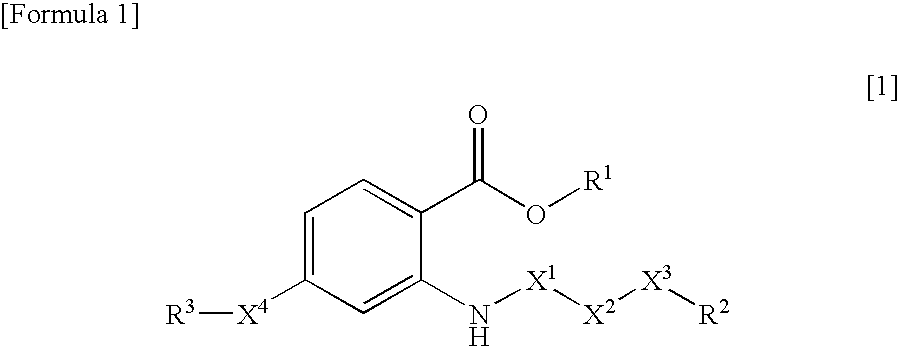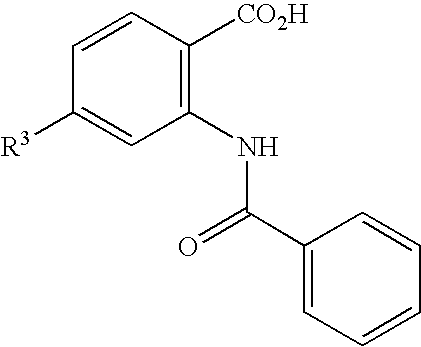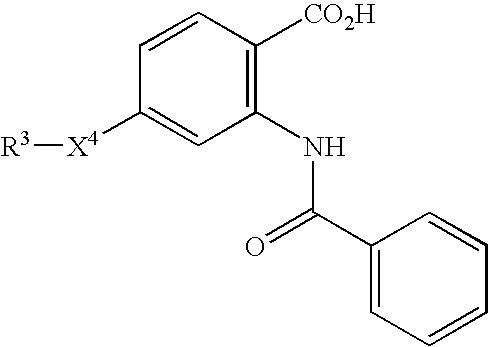Novel anthranilic acid derivative or salt thereof
a technology of anthranilic acid and anthranilic acid, which is applied in the field of new anthranilic acid derivatives, can solve the problems of cartilage cell pathological chang
- Summary
- Abstract
- Description
- Claims
- Application Information
AI Technical Summary
Benefits of technology
Problems solved by technology
Method used
Image
Examples
referential example 1
[0207]
[0208]To 40 mL of acetone solution containing 4.0 g of 4-bromo-2-nitrobenzoic acid, 3.4 g of potassium carbonate and 2.3 mL of dimethyl sulfate were added at room temperature and stirred at 50° C. for 1 hour. After the reaction mixture was cooled to room temperature, the solvent was evaporated under reduced pressure. Water and ethyl acetate were added to the obtained residue. The organic layer was separated and dried over anhydrous magnesium sulfate after washed with a saturated sodium hydrogen carbonate aqueous solution, 1.0 mol / L hydrochloric acid and a saturated sodium chloride aqueous solution sequentially, and the solvent was evaporated under reduced pressure to obtain 4.1 g of methyl 4-bromo-2-nitrobenzoate as white solid.
[0209]1H-NMR (CDCl3) δ: 3.97 (3H, s), 7.85 (1H, d, J=8.3 Hz), 8.07 (1H, dd, J=8.3, 2.0 Hz), 8.47 (1H, d, J=2.0 Hz).
referential example 2
[0210]
[0211]To 50 ml, of M, N-dimethylacetamide solution containing 5.0 g of 4-bromo-2-nitrobenzoic acid, 41 g of potassium carbonate, 4.6 g of benzyltriethylammonium chloride and 69 mL of 2-bromo-2-methylpropane were added at room temperature and stirred at 55° C. for 10 hours. After the reaction mixture was cooled to room temperature, 12 mL of 2-bromo-2-methylpropane was added and stirred at 55° C. for 4 hours. After the reaction mixture was cooled to room temperature, water and ethyl acetate were added. The organic layer was separated and dried over anhydrous magnesium sulfate after washed with 10% citric acid aqueous solution and a saturated sodium chloride aqueous solution sequentially, and the solvent was evaporated under reduced pressure. Methanol was added to the obtained residue and solid substances were separated by filtration to obtain 3.0 g of tert-butyl 4-bromo-2-nitrobenzoate as white solid.
[0212]1H-NMR (CDCl3) δ: 1.55 (9H, s), 7.63 (1H, d, J=8.3 Hz), 7.77 (1H, dd, J=8...
referential example 3
[0213]
[0214]2.6 g of iron powder was added to a mixed solution of 20 mL of methanol and 20 ml, of acetic acid containing 4.0 g of methyl 4-bromo-2-nitrobenzoate, and the resulting mixture was heated to reflux for 3 hours. After the reaction mixture was cooled to room temperature, a saturated sodium hydrogen carbonate aqueous solution and ethyl acetate were added and insoluble were removed by filtration. The organic layer was separated and dried over anhydrous magnesium sulfate after washed with a saturated sodium hydrogen carbonate aqueous solution and a saturated sodium chloride aqueous solution sequentially, and the solvent was evaporated under reduced pressure. Hexane was added to the obtained residue and a solid substance was separated by filtration to obtain 2.0 g of methyl 2-amino-4-bromobenzoate as white solid.
[0215]1H-NMR (CDCl3) δ: 3.89 (3H, s), 4.20 (2H, s), 7.26 (1H, dd, J=8.3, 2.1 Hz), 7.43 (1H, d, J=2.1 Hz), 7.47 (1H, d, J=8.3 Hz).
PUM
| Property | Measurement | Unit |
|---|---|---|
| time | aaaaa | aaaaa |
| temperature | aaaaa | aaaaa |
| temperature | aaaaa | aaaaa |
Abstract
Description
Claims
Application Information
 Login to View More
Login to View More - R&D
- Intellectual Property
- Life Sciences
- Materials
- Tech Scout
- Unparalleled Data Quality
- Higher Quality Content
- 60% Fewer Hallucinations
Browse by: Latest US Patents, China's latest patents, Technical Efficacy Thesaurus, Application Domain, Technology Topic, Popular Technical Reports.
© 2025 PatSnap. All rights reserved.Legal|Privacy policy|Modern Slavery Act Transparency Statement|Sitemap|About US| Contact US: help@patsnap.com



